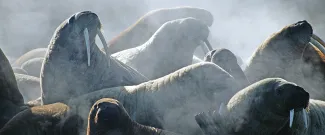
Photo: Shutterstock
Some might be surprised to learn that the bones of ancient walruses can be found alongside those of woolly mammoths and steppe bison. Every spring and summer, the waves of the Beaufort Sea wash a curious mix of fossils onto the beaches that surround Herschel Island off the north coast of Yukon. These beaches are some of the most significant fossil localities in Yukon, and are the only place in Yukon where remains of ice age marine mammals can be found.
The lives of walruses are closely tied to Arctic sea ice. Moving pack ice provides a surface for molting, pupping, and resting between foraging trips to the shallow sea floor. Walruses are not very good divers compared to other large marine mammals, but have been observed diving to about 80 metres deep to feed. Walruses generally prefer molluscs such as clams, but they will also eat other invertebrates, fish, and sometimes seals!
The only known predators of the walrus are orcas, polar bears and humans. In historic times, overhunting had significant negative impacts on both Pacific and Atlantic populations and led to the extirpation of one population that was historically found in the Canadian Maritimes.
During glacial periods of the Ice Age, when continental glaciers covered much of Canada, the Bering land bridge became exposed and sea ice covered the entire Arctic Ocean throughout the year. these changes had a dramatic impact on walrus populations, pushing them far down the coast of the southern United States. Ice age walrus fossils can be found as far south as California and South Carolina, well beyond their present day range. The initial division into what would become the Pacific and Atlantic subspecies likely occured during one of these glacial periods, possibly more that 150,000 years ago.
Yukon's Walrus Story
The study of walrus fossils from Herschel Island has only recently begun. When walrus bones were first collected near the historic settlement of Pauline Cove on Herschel Island, they were assumed to be those from modern animals that had recently died. However, walruses are rarely seen in the waters surrounding the island today. Yukon territorial park rangers last documented a living walrus in Pauline Cove around 1990. Over the last few decades, only a dozen or so walrus fossils have been found on Herschel Island.
When the first radiocarbon dates were obtained from the walrus fossils, scientists were surprised to learn that these bones represented animals that were living during the Ice Age, more than 50,000 years ago! Interestingly, since the Arctic was locked in sea ice for most of the Ice Age, these walruses must have been living in the Beaufort Sea when climates were warm, like present day, and the Arctic was ice-free in the summer. The last time sea ice conditions resembled present day, and there was no Bering land bridge, was around 125,000 years ago.
Curious to see how the Herschel Island walrus fossils were related to the living Pacific and Atlantic populations, scientists carefully analyzed the ancient DNA preserved in these bones. The results suggest that the Herschel Island fossil walruses may have been part of the ancient population that included the ancestors of all walruses living today. Further genetic studies from other ancient and modern walruses across their entire range suggest that walruses split into two unique populations during glacial times. As the climate warmed, walrus populations likely became smaller and retreated northward to the Arctic sea ice limits.
Distinctive patterns preserved in ancient sea floor sediments exposed along the coast of Washington state show evidence of ice age walruses digging the mud with their tusks to retrive clams and shell fish.

